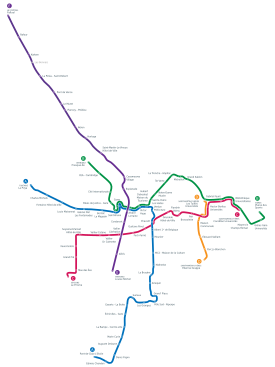Our website is made possible by displaying online advertisements to our visitors.
Please consider supporting us by disabling your ad blocker.
Grenoble tramway
| Grenoble tramway | |||
|---|---|---|---|
 | |||
| Overview | |||
| Native name | Tramway de Grenoble | ||
| Locale | Grenoble, Rhône-Alpes, France | ||
| Transit type | Tram | ||
| Number of lines | 5 | ||
| Number of stations | 82 | ||
| Daily ridership | 233,700 (2015) | ||
| Operation | |||
| Began operation | 1987 | ||
| Operator(s) | Société d'Économie Mixte des Transports Publics de l'Agglomération Grenobloise (SEMITAG) | ||
| Technical | |||
| System length | 43.7 km (27.2 mi) | ||
| Track gauge | 1,435 mm (4 ft 8+1⁄2 in) standard gauge | ||
| Electrification | 750V DC overhead | ||
| |||
The Grenoble tramway (French: Tramway de Grenoble) is the tram system in the city of Grenoble in the Rhône-Alpes region of France. In 1987, Grenoble became the second French city to reintroduce trams, the first being the Nantes tramway. The current network is 35-kilometre (22 mi) long, and comprises five lines: lines A, B, C, D and E. Line A was opened in 1987, line B in 1990, line C on 20 May 2006, line D in October 2007 and line E on 28 June 2014.
The tramway is operated by the Société d'économie mixte des transports publics de l'agglomération grenobloise (SÉMITAG) on behalf of the Communauté d'agglomération Grenoble Alpes Métropole, the intercommunal structure linking the commune of Grenoble and its suburbs. SÉMITAG operates its services, which includes local bus services as well as the tramway, under the Tag brand.
Previous Page Next Page



